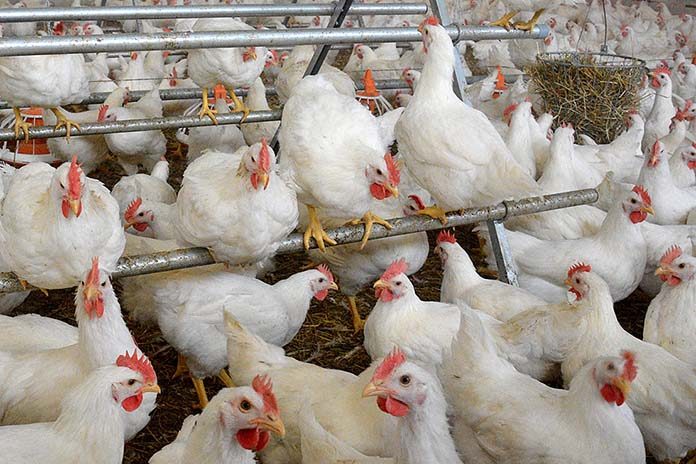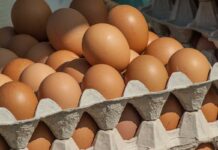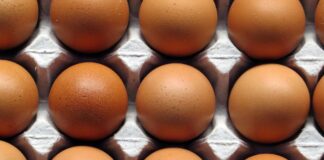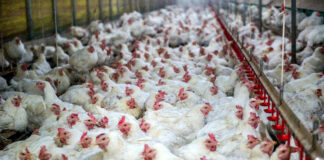
Poor leg health in Australian fast growing meat chickens is a major welfare issue, resultant from long-term genetic selection for bird size and growth rate (Bessei 2006).
Anecdotal evidence and preliminary data suggest perches may have the potential to improve leg health, decreasing the prevalence of associated leg disorders and lameness (Groves and Muir 2013).
The following study sought to assess the potential role of perches in improving leg health in the context of Australia’s fast growing meat chicken industry.
Day old chicks, both Ross 308 and Cobb 500 were randomly allocated into one of four treatments within a 2 by 2 factorial for breed with and without a perch. There were 6 pens per treatment, and 42 birds per pen (density 28kg/m2). Perches were an A-frame, with two levels, one 15cm, the second 30cm above the ground, each providing 1 metre of perch. Observations of activity and spatial distribution and perching behaviour were recorded every two days at five time points throughout the six-week study. At 35 days of age (d) the standing ability of 9 visually male birds per pen (54 per treatment) was assessed in a latency to lie (LTL) test, after which a sample of blood was collected to determine serum Ca, P and Mg, and assessments of breast blisters, hock marks and footpad dermatitis were completed. At 42 d, a further 9 visually male birds per pen underwent the LTL test. Blood was taken, each bird was then humanely euthanased and breast, hock and footpads were assessed in addition to tibial dyschondroplasia (TD). Bird weights and feed conversion ratio (FCR) were measured throughout.
Birds used the perches from 6 d to 42 d, with 1.25% of birds using the perches at any given time. Perch use peaked at 38 d and in the final two weeks of the study, female birds used the perches more than males (P<0.001). Perches did not affect bird spatial distribution (p=0.78), nor litter moisture (p=0.059), but Cobb birds were observed resting less than Ross (p=0.001). Bird weights were not impacted by the presence of perches nor were they significantly different between strains (p=0.186). Ross FCR was lower than Cobb (p=0.02).
The perches had minimal impact on leg health. LTL times showed no effect of perches at either 35 d (p=0.58) or 42 d (p=0.87). Serum levels were largely unaffected by treatment, although notably, Cobb birds with access to perches had lower serum magnesium at 35 (p=0.01) and 42 d (p=0.001). Ross birds experienced more footpad dermatitis than Cobb at 35 d (0.031) and 42 d (0.045). Overall, the prevalence of TD was low (0.5% birds sampled). These LTL results are contradictory to those observed by Groves and Muir (2013) and are being retested in subsequent studies. Evaluation of the relationship between the amount of perch space with leg strength and bird physiology are also being evaluated.
Acknowledgement: DV Phibbs is the recipient of the 2017 RSPCA Australia Scholarship for Humane Animal Production Research.
References
Bessei W. (2006) World’s Poultry Science Journal 62: 455-466.
Groves PJ & Muir WI (2013) European Symposium on Poultry Welfare 4: 43.
From the 2019 Australian Poultry Science Symposium

















